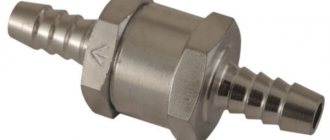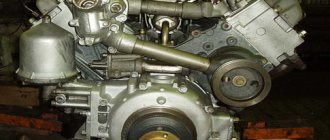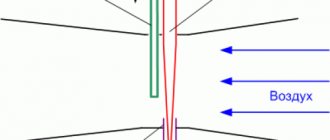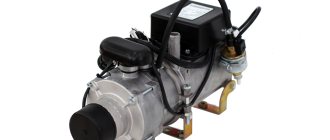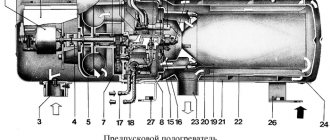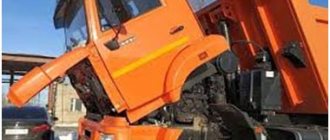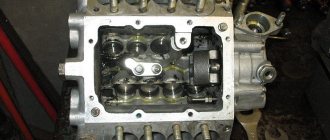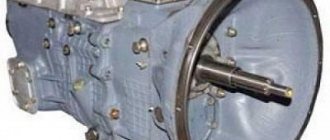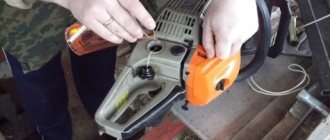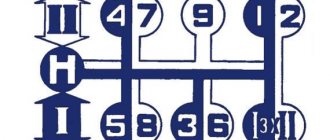Engines KAMAZ mod. 740.31-240, 740.30-260, 740.51-320 and 740.50-360 in serial production are equipped with high-pressure fuel pumps (HPF): - type 337 "YAZDA", Yaroslavl - type P7100 "BOSH".
Fuel injection pump "YAZDA" type 337.
The design of the block V-shaped pump of JSC "YAZDA" consists of a high-pressure pump, a low-pressure fuel pump, a speed controller and a charge air corrector. The low-pressure fuel pump supplies fuel under the required pressure to the injection sections of the injection pump, which are located in the V-shaped pump housing.
Technical characteristics of YAZDA fuel injection pump for Euro-2 engines
| Parameter | 337-20.05 | 337-20 | 337-20.03 | 337-20.04 |
| Plunger diameter, mm | 11 | |||
| Plunger stroke, mm | 13 | |||
| Fuel dosing method | Spiral edge | |||
| Average cyclic fuel supply at nominal mode, mm3/cycle | 99,0 –103,0 | 104,0 – 108,0 | 132,0 – 137,0 | 147,0 – 152,0 |
| Nominal camshaft rotation speed, min -1 | 1100±10 | |||
| Average cyclic fuel supply at minimum idle speed, mm3/cycle | 15 — 20 | |||
| Rotation speed at minimum idle speed, min -1 | 300±10 | |||
| Rotation speed at maximum torque mode, min -1 | 700±10 | |||
| Average cyclic fuel supply at a rotation speed corresponding to the maximum torque, mm 3 /cycle | 103,0 – 110,0 | 116,0 – 121,0 | 137,0 – 143,0 | 155,0 – 160,0 |
| Average cyclic fuel supply at rotation speed n=500 min-1, mm3/cycle | 87,5 – 97,5 | 87,5 – 97,5 | 87,5 – 96,5 | 87,5 – 96,5 |
| The average cyclic fuel supply at starting mode (n=100 min-1) should be, mm3 / cycle | 195,0 – 220,0 | |||
| Air pressure corresponding to the start of the boost corrector in the direction of increasing fuel supply, MPa (kgf/cm2) | 0,01 – 0,015 (0,10 – 0,15) | 0,01 – 0,015 (0,10 – 0,15) | 0,015 – 0,02 (0,15 – 0,20) | 0,015 – 0,02 (0,15 – 0,20) |
| Air pressure corresponding to the end of the boost corrector in the direction of increasing fuel supply, MPa (kgf/cm2) | 0,025 – 0,03 (0,55 – 0,30) | 0,035 – 0,04 (0,35 – 0,40) | 0,04 – 0,045 (0,40 – 0,45) | 0,05 – 0,055 (0,5 – 0,55) |
Nozzles and sprayers
On KamAZ Euro-2 engines 740.30-260, 740.31-240, 740.50-360, 740.51-320 with fuel injection pump type 337 (V-shaped), an injector model 273-20 manufactured by JSC YaZDA, Yaroslavl is used.
Design and principle of operation
The fuel injection pump device includes such mechanisms as:
- pump compartment housing;
- high pressure fuel pump bearing cover housing;
- inflation hose;
- plunger pair and plunger pusher;
- spring elements;
- mode selection regulator and coarse and fine filters;
- fitting for the fuel drain and injection system;
- fuel injection regulator;
- pressure reducing valve;
- an electromagnetic valve, which is necessary to shut off the fuel supply;
- rack, nozzle and coupling half.
The operating principle of the injection pump is as follows:
- Movement is set from the crankshaft mechanism using a mechanical transmission.
- The rotation of the cam shaft begins. This rotation provokes displacement of the pusher elements.
- The pushers begin to compress special springs.
- The springs cause the plunger to start working and lift it.
- The plunger closes the intake valve and displaces fuel fluid.
- The fuel begins to be sprayed using nozzles.
- The plunger lowers and opens the intake mechanism.
Where is the check valve located?
The check valve allows fuel to flow in only one direction - from the fuel tank to the engine. When the engine is turned off, it blocks unused fuel from draining back into the fuel tank. Do not confuse a check valve with a pressure reducing valve, which regulates the fuel pressure when supplied to the injectors; in the event of a malfunction of the valve, the fuel would be supplied without pressure, which makes it impossible for it to move further into the engine.
The check valve is located on the fuel rail between the fuel tank and the injectors. This arrangement allows, in addition to the main functions, to regulate the pressure at the injection pump inlet. On KamAZ models intended for operation in Arctic conditions, the OK is located in front of the heating system.
Types of fuel pumps
First, let's look at the types of fuel pumps for diesel cars, since each of them has its own characteristics and typical fuel injection pump malfunctions. So, knowing what type of pump it is, you can better understand the principle of operation and the immediate cause of the breakdown. Regardless of the type of high-pressure pump, you need to understand that the main unit is the so-called plunger pair - a piston (plunger) and a cylinder (bushing).
There are two main types of injection pumps:
- with direct action and mechanical action of the plunger;
- with battery injection.
However, high-pressure fuel pumps are still divided into classes according to their design. In particular:
- Rows . As the name implies, their working sections are arranged in one row, and fuel is supplied to each cylinder in turn.
- Distribution . With such pumps, one section can supply fuel to several different cylinders. Such devices can be single- or double-plunger.
- Multi-sectional . Another name for them is V-shaped or hydraulic accumulators. They are used for highly powerful, but low-speed engines. They are quite rare.
With direct injection fuel pumps, pumping and injection occur simultaneously. The mechanical drive of the plunger is responsible for this. With battery pumps, fuel is supplied in separate cycles, first it enters the pump accumulator, and only then into the injectors. The most modern systems are controlled electronically and are called Common Rail. They work based on information from numerous sensors located in different parts of the car.
Another injection system is a pump injector. In this case, they are combined into one mechanism. This system simplifies pressure control and also increases reliability, because if one injector fails, the engine will continue to operate, albeit with less power.
High-pressure fuel pumps were also invented for gasoline engines. They are used in engines with direct fuel injection. The pump's job is to supply gasoline under high pressure into the cylinders, where the fuel is directly mixed with the air mass, forming a mixture that is ignited by the spark plug.
Bosch KamAZ Euro-3 injection pump: design and adjustment
The German fuel injection pump for KamAZ Euro-3 is a common component of new models. However, Bosch pumps break down more often. The fact is that operating conditions for trucks in Russia are very different from German ones, so many owners replace Bosch fuel injection pumps with YAZDA (Yaroslavl plant). The latter are inferior in the accuracy of measuring portions of incoming fuel, but are better suited for use on local roads.
The design of the Bosch KamAZ Euro-3 fuel injection pump is not fundamentally different from Euro-2 or domestic fuel injection pumps.
For proper operation, regular diagnostics of the injection pump and adjustment are necessary, which is necessary in the following cases:
- Increased fuel consumption
- No fuel supply to the injector
- Noises in the pump
Regulation of the restored injection pump
After all problems in the operation of the injection pump and the reasons that led to their occurrence have been eliminated, you should begin to adjust and configure its nominal operating parameters. This complex technical operation requires special knowledge and the use of appropriate equipment.
In particular, it is necessary to set the levers in the correct kinematic position. In this case, the tolerances on their spatial location can be fractions of a millimeter (for example, the error in the distance between the mating plane of the pump housing and the head of the nominal flow bolt should be no more than ±0.2 mm).
You should also check the opening pressure of the discharge valves and their tightness. To do this, fuel is supplied under pressure to the injection pump head (the supply must be turned off). If fuel is leaking from the pump drain pipes, the discharge valve must be completely replaced.
All these and other operations should be carried out only with the use of specialized technical means designed for effective and high-quality repair of KamAZ diesel fuel equipment.
Bosch KamAZ Euro-2 injection pump: design and adjustment
Bosch Euro-2 injection pump consists of:
- Frame
- Injection advance clutch
- All-mode regulator
- Plungers
- Booster pump
- Shaft
- Springs
- Valves
Bosch injection pump control can be mechanical or electronic; Euro-2 is often equipped with electronic control.
Most often, breakdowns occur during long-term operation; plungers and pumps wear out. Due to these breakdowns, fuel is supplied in larger quantities or not supplied at all.
In order to prevent damage to the fuel injection pump, it is necessary to remove sediment from the coarse filter daily and change the fine filters several times a year. If the injection pump breaks down, it is better to contact a specialist.
Malfunctions and repairs
You can repair KamAZ fuel injection pump yourself if you have the necessary tools and equipment.
Main fuel injection pump malfunctions and reasons for their occurrence:
- Water in the fuel mechanism. This breakdown may indicate a malfunction of the fuel filter element, diluted fuel, or a leak in the fuel drives.
- Reduced and uneven supply of working fluid. In this case, it is recommended to check the plunger for damage, and also inspect the discharge valves and rack clamps. The capacity of the injectors should be checked.
- The diesel fuel is running out. The cause of this breakdown may be a leak in the fuel drive. The damaged element should be replaced.
- The drive is tearing. It is recommended to inspect the crankshaft, as well as the main components of the power unit for damage and foreign bodies.
- Delay of the working fluid injection system. Such a malfunction can be caused by damage to the plane of the adjusting bolt of the pusher element, the roller axis and failures in the rotation speed of the cam shaft.
How to remove and disassemble
Removal from engine:
- Remove the terminal from the battery.
- Remove the radiator.
- Remove the vacuum pump.
- Remove the oil dipstick guide pipe.
- Remove the oil filter filter mechanism.
- Turn the crankshaft in the direction of rotation until it stops.
- Disconnect fuel drives.
- Remove the vacuum hose.
- Block the crankshaft from turning.
- Unscrew the bolt in the center of the coupling.
- Remove the chain tensioner.
- Pull out the pump by dismantling the fuel pedal drive.
Disassembling the KamAZ fuel injection pump is done as follows:
- It is necessary to remove the metering type valve from the end of the pump housing. To do this, you need to unscrew the bolts of the pressure plate and release the advance valves of the injection system.
- Then you should remove the fastenings on the top cover.
- You need to disassemble the control board to gain access to the electronics.
- It is necessary to set the required position of the crankshaft.
- Then you need to dismantle the bearing using special equipment.
- At the end, all parts should be washed and their surface polished.
Adjusting the pneumatic corrector
The function of the KamAZ 740 injection pump pneumatic corrector is to regulate the fuel supply. When the air flow pressure decreases, the amount of fuel supplied is reduced, which prevents overheating and smoking of the engine. Also, the operation of such equipment affects engine oil consumption: if everything is in order, then oil consumption is uniform.
Adjusting the pneumatic corrector allows you to change the amount of fuel entering the injectors. The whole process is very simple, does not have a complex sequence of actions and can be easily done with your own hands. The pneumatic corrector is adjusted by two bolts:
The first is responsible for spring tension and is located coaxially with the spool. The corrector operates at increased pressure, which means it is necessary to increase the spring tension by tightening the bolt.
The second screw is responsible for the direct supply of fuel; unwinding it will increase the volume of incoming fuel.
On the Internet you can find pictures and videos showing step-by-step adjustment of the corrector. Fuel supply corrector circuit:
How to add or reduce fuel
Adjusting the Bosch injection pump on KamAZ makes it possible to add fuel, i.e. set the required fuel supply value.
Procedure for reducing fuel:
- Using a key of 13, you need to adjust the air flow to the mechanisms of the power unit. Thanks to this, diesel will be able to mix with air.
- Make adjustments to the corrector and start the motor for testing.
- If necessary, you need to further tighten the air flow until the smoke stops coming out.
In order to add fuel to the KamAZ injection pump (Euro-2 or Euro-3), you need to do the following:
- Tighten the special screws that are located in the upper and side parts of the working fluid supply.
- When unscrewing the bolts, you need to increase the gap for the passage of the combustible mixture. This will help normalize the performance of the power unit and the lubrication system of the high-pressure fuel pump.
- Having increased the diameter of the hole, you should start the engine and check the operation of all systems.
How to install correctly
Installation (installation) of the fuel pump must be carried out using special equipment.
In order to correctly supply and install a high-pressure fuel pump on a KamAZ truck, do the following:
- The vehicle is installed on a special platform.
- Mount the driven clutch onto the advance clutch and secure everything with bolts.
- Turn the coupling so that the bosses of the driven type coupling half are in a horizontal position, and the mark on the end part is in the pointer area.
- Install the flange assembly with the drive coupling half and plate packs. The flange should be located on the left side of the housing.
- Install the fuel pump along with the coupling onto the engine and secure everything with mounting bolts.
- Before tightening the bolts, adjust the flatness of the plate packs by moving the flange along the drive shaft.
- The pump is mounted on a block of cylindrical elements in a vertical position, preventing it from blocking.
- The injection pump sections are connected to the injectors.
- Adjust the advance angle of the injection system.
- Check the presence of oil fluid in the injection pump housing.
- Connect the oil inlet and outlet pipes.
Signs of injection
There are two points of incorrectly adjusted injection:
Since there can be two incorrect settings, each of them has its own symptoms. It is important to correctly distinguish between the symptoms indicating these failures.
Late injection
This is a situation in which the check valve of the KamAZ 740 fuel injection pump is already lowering from the maximum upper point, and the fuel is just starting to flow, and an explosion follows.
In the functioning of the power unit, this is shown by several signs.
- White exhaust gases, especially when the engine is cold.
- The number of revolutions increases.
- It works smoothly.
- Quiet pressing of the gas pedal is accompanied by shaking of the engine at medium speeds. Afterwards it seems to break through, and the shaking disappears at elevated levels.
- KamAZ doesn't pull well.
- Increased fuel consumption.
- Overheat.
Early injection
A situation in which the piston has not reached its maximum point, but the combustible mixture is already entering, the explosion is directed towards the piston. The following signs indicate a problem:
- hard operation of the motor;
- with a sudden change of gas and increased load, a ringing is noted, and with increasing temperature the sound intensifies;
- if the injection occurs too early, white smoke is observed from the exhaust pipe;
- weak traction;
- increased fuel consumption.
Reference! The torque set at the factory is usually a little late.
